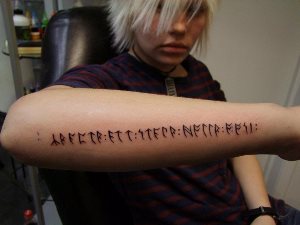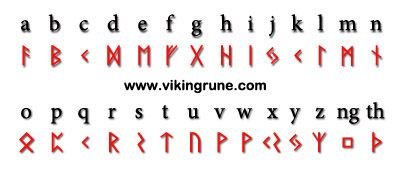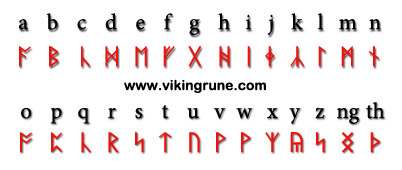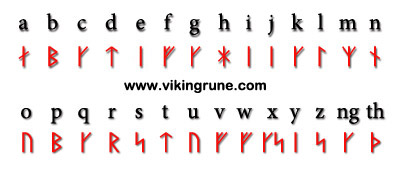 Developing a great design for a tattoo is critical in case you seriously plan to get inked. If you are about to have a Norse or Viking tattoo, I bet you want to include some Nordic runes into it. Tattooed inscriptions in foreign languages or written in unusual characters may well be a source of trouble, especially if you don’t know well the language or the writing system. Online translation tools may play a trick on you: a woman who wanted to have “I love David” in Hebrew on her back, later realized the actual tattoo said “Babylon is the world’s leading dictionary and translation software”. David Beckham inked his wife’s name on his left forearm in Hindi but misspelt it. The tattoo read Vihctoria instead of Victoria with additional h. The name is well known in India because of Queen Victoria, so the person who developed the tattoo design probably wasn’t a native Hindi speaker and even did not know the language well. Perhaps you wouldn’t like to be in such a situation with your runic inscription, would you?
Developing a great design for a tattoo is critical in case you seriously plan to get inked. If you are about to have a Norse or Viking tattoo, I bet you want to include some Nordic runes into it. Tattooed inscriptions in foreign languages or written in unusual characters may well be a source of trouble, especially if you don’t know well the language or the writing system. Online translation tools may play a trick on you: a woman who wanted to have “I love David” in Hebrew on her back, later realized the actual tattoo said “Babylon is the world’s leading dictionary and translation software”. David Beckham inked his wife’s name on his left forearm in Hindi but misspelt it. The tattoo read Vihctoria instead of Victoria with additional h. The name is well known in India because of Queen Victoria, so the person who developed the tattoo design probably wasn’t a native Hindi speaker and even did not know the language well. Perhaps you wouldn’t like to be in such a situation with your runic inscription, would you?
Many runic tattoo designs include a name. You may want to have inked in runes the name of a beloved one, your own name, or a name of a deceased person who was important in your life. Now if we are to spell it in the Elder Futhark runes, we have to look deeper into what spelling is and have a look at the following facts:
-
The ideal alphabet has a separate symbol (letter or rune) for each sound the language has.
-
The Elder Futhark runic alphabet was such an ideal system: there are as many Elder Futhark runes as there were sounds in the Proto-Norse language, for which they were developed.
-
Roman letters used to transcribe the English language today do not constitute an ideal alphabet. Several sounds (have a look at the IPA chart of English) do not have letters of their own. They are transcribed with letters or combinations of letters used for other sounds as in ch for [tʃ] and sh for [ʃ].
-
The Phonological system (sound system) of the Proto-Norse language was not the same as in modern English. It had sounds that do not exist in English. It also did not have some sounds that do exist in English: for instance English has the sounds [tʃ] [dʒ] [ʃ] [ʒ], whereas Proto-Norse did not have them.
-
If we try to use the Elder Futhark runes phonetically, that is substituting runes for the sounds we hear, the way runes were supposed to be used, we will fail, because there are not enough runes for all the English sounds.
So the solution is to keep modern English spelling. It is true that ancient rune carvers did not use it. However, it is also true that they did not have to transcribe words containing sounds like [tʃ] [dʒ] [ʃ] [ʒ]. Should they have to, they would invent a way to do so. Not necessarily combining s and h for [ʃ] as in ‘shame’ or c and h for [tʃ] as in ‘child’. May be they would even invent something more logical than using as many as three variants for one and the same sound [dʒ] as in ‘gin’, ‘joy’, and ‘edge’.
Even though keeping the English orthography eliminates the most of the problems, some still remain. First, there are 26 Roman letters in the English alphabet and only 24 runes in the Elder Futhark. Second, not all of the runes have obvious counterparts in Roman letters, for instance the *eihwaz rune denoted a phoneme with the sound value between [i] and [e]. Since we have *isa and *ehwaz for English i and e, *eihwaz remains unemplyed. Below is a table of letters and their runic counterparts, showing how all this can be resolved:

Note that this way to collate letters and runes is not canonical. It is based on my own understanding of phonology and orthography. No one has ever decreed ex cathedra that such a set of counterparts—fixed as the ‘right’ or ‘correct’ one—should at all exist. There has been no social contract concluded to this effect, either. An algorithm based on this table is behind the rune converter that I developed. You may see other tables of counterparts on the Internet that suggest different solutions. Keep in mind that you may also find phonetic explanations of runes, which were not compiled as a help for those who want to write a name in runic symbols. In such cases as my earlier post the counterparts denote the letters used to transcribe ancient runic inscriptions. Here is also the table for the Anglo-Saxon runes known as the Anglo-Saxon Futhorc:

The Younger Futhark runic alphabet has only 16 runes. It uses one and the same rune for such pairs as [p] and [b], [t] and [d], [k] and [g]. So such names as ‘Tina’ and ‘Dina’ will look the same in these runes. The words ‘Pat’, ‘pad’, ‘bat’ and ‘bad’ will be identical as well. So before any permanent use I would strongly advise to check for all possible readings of the resulting Younger Futhark rune sequence. If the name can be read as some other word as well, you’d better know it before you get a tattoo. For example, the word ‘big’ may be read ‘pig’ as well, which may turn as a rather unpleasant surprise. Since the same rune is used for both [i] and [e], the same word in runes may also be read as ‘beg’ and ‘peg’. Note that there is only one rune for [u] and [o], too. The table for the Younger Futhark runes is as follows:

The appearance of runes in the charts above is not the only possible one. There have been many variants of runes depending on geographical area and historical period. For instance, beside the so called long branch Younger Futhark, pictured above, there was a short twig variant as well. Later it was transformed into the so called medieval runes.
Note that the principles set up in this article are apllicable not only to names, but to any word, phrase or text in English as well (however, not to Old Norse texts).
See also:
A Guide to Writing in Norse Runes
How to Translate into Runes Correctly
How to Write an Authentic Runic Inscription
Should I Write in Runes Phonetically?
Photo courtesy © NirvanaOfTime

Ive been trying for a while to come up with the runic spelling of my last name, it is Ruona, Ive been told that it is Finnish. A.) I was wondering if you had any idea if this is a common last name in Finland. B.) Could you help me with the proper way of representing my last name with runes. My family on my mother side is heavily Scandinavian and I wanted to celebrate this with a runic tattoo. Any help would be appreciated. Thank you
Hello Ruona. My rune converter will probably help you to represent your name in runes.
Should I be using elder futhark? Or which one would you suggest?
There is no ‘right’ or ‘wrong’ option. It’s up to you to decide.
Hello,
Im looking to get some clarification on my last name “Wike”? If your familiar of where it may have came from. I’ve been told its Norwegian, but haven’t found anything to verify it anywhere. Thank you!
Hello Seth. It may be a variant of Norwegian and Swedish family name Vik. It could have been derived from any of numerous farmsteads all over Norway and Sweden, so named with Old Norse vík ‘small bay’, ‘inlet’.
Greetings. My father and i have been trying to find a good father son tattoo. Being that my father moved from denmark where my family is from, to canada where i was born i would like to go into our ancestry and have viking inspired design, along with our last name ‘Brink’ in rune. What would be your suggestion of rune to translate our name to? Much appreciated!
-Jordan
Hello Jordan. Your family name seems to be from Middle Low German brinc ‘edge’, ‘slope’, ‘grazing land’, especially a raised meadow in low-lying marshland, a topographic name for someone who lived by a pasture or green. It is cognate to English brink and Old Norse brekka. The common Proto-Germanic (reconstructed) ancestor word for all these is *brinkaz. In the Elder Futhark runes it would have looked as follows:
Old Norse brekka in the long branch Younger Futhark runes would have looked like that:
Or else, if you simply want to have the name Brink in its modern orthography in Viking runes, here it is:
Greetings! I’m inquiring how the surname ‘Fisk’ would have originally looked in rune form (for tattoo purposes), seeing as the name being of a Nordic decent. Also I am very curious about the heritage behind the name (like most probable country location etc) and if it was of any significance, all I know is that it means ‘Fish’, which I find humorous as my last name. If you could shed any light in both areas, it would be much appreciated! Cheers.
Hello. The Old Norse word for fish was fiskr. In runes it would have looked as follows:
The name for the Norse chalice called ‘Odrerir’ appears rarely. I’ve only seen two spellings but only in Romanised form. Any ideas as to how this would be put into rune form?
The Old Norse spelling of the word was not stable. It was spelt either Óðrerir or Óðrørir or else Óðrœrir. In Younger Futhark runes the word would probably have been spelt either this way:
or this:
Looking to get a translation on my grandfathers last name “olsen”
not sure exactly which runic alphabet to use
Hello Steven. Probably the Younger Futhark. It was in use during the Viking Age.
i’m wondering which variant of writing the runes works best for the names
‘jamilla’ and ‘aiden’. thoughts?
Any of them works just great, Aiden.
Hi,
I’m thinking of getting my house name “Glynarde” tattooed. Is there any problems I should look out for with this word? I should add, I am from Orkney and would like some advice about the kind of runes found there.
Thanks you very much!
Hello Beth. The Younger Futhark Maeshowe inscription has a mixture of Long Branch and Short Twig forms. You may want to base your design on this Orkney style inscription.
I’d like to know how “Freyja” would be written in Elder Futhark. It seems that such a name would be possible to write with runes because it was used during the same time by the same people who used runes, so the phonetic translation into runes doesn’t seem to me like it should be an issue. However, being that there aren’t any existing runic inscriptions of “Freyja” that I can find, I was trying to figure out if “Fehu, Raido, Ehwaz, Jera, Ansuz” would definitely be the way it would have been written. Thanks!
Hello Alexandra. Freyja is an Old Norse form. The Younger Futhark, not Elder Futhark runes were in use at the time.
Hi my son is called odin and i wanted a tattoo of his name but decided to get it in rune to have it a bit different to go with the roots of the name odin. We havent any of this in our bloodline, its just purely to go with his name.
Would you reccommend just using elder futhark to translate it? I used your converter to check i had it written ok and i like the way it looks but i just wanted to get your opinion. Id like a symbol of odin too but not sure which ones really for him accurately.
Thanks for your help
Hello Ashley. During the Viking Age the name was pronounced Óðinn and the Younger Futhark runes were in use. The Elder Futhark runes are much older and closer to the Proto-Germanic language, when the name is reconstructed to have been pronounced as *wōđanaz. So if you simply write Odin with the Elder Futhark runes, it is a possible option but it would be a combination of spelling and runic alphabet that existed at very different times.